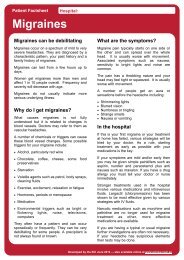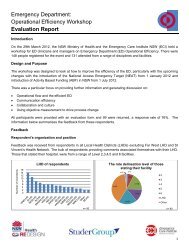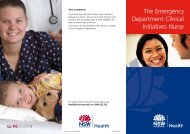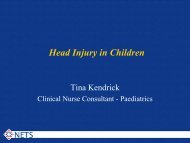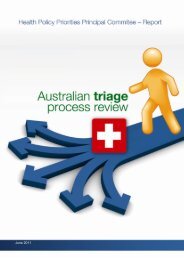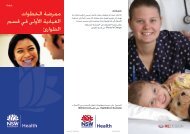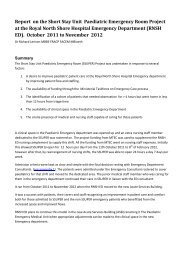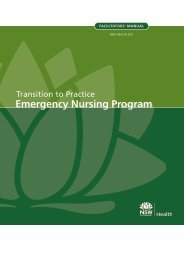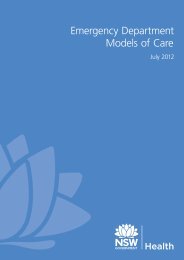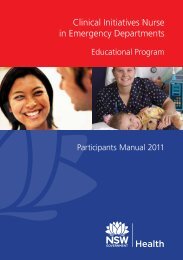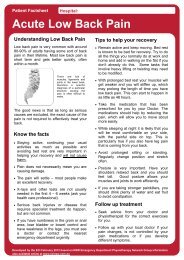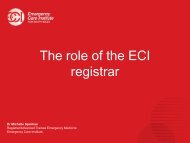Allied Health Profession Staffing in Queensland Health Emergency ...
Allied Health Profession Staffing in Queensland Health Emergency ...
Allied Health Profession Staffing in Queensland Health Emergency ...
Create successful ePaper yourself
Turn your PDF publications into a flip-book with our unique Google optimized e-Paper software.
<strong>Allied</strong> <strong>Health</strong> Workforce Advice and Coord<strong>in</strong>ation UnitDISCUSSION PAPER:ALLIED HEALTH PROFESSION STAFFINGIN QUEENSLAND HEALTHEMERGENCY DEPARTMENTSMARCH 2011(This paper was endorsed by the State-Wide<strong>Emergency</strong> Department Cl<strong>in</strong>ical Networkon 15 March, 2011)Page 1 of 32
<strong>Allied</strong> <strong>Health</strong> Workforce Advice and Coord<strong>in</strong>ation UnitINTRODUCTIONIn May 2010 the <strong>Queensland</strong> <strong>Health</strong> <strong>Allied</strong> <strong>Health</strong> Workforce Advice and Coord<strong>in</strong>ation Unit was contacted bythe State-Wide <strong>Emergency</strong> Department Network (SWEDN) and <strong>in</strong>vited to contribute to the State-Wide<strong>Emergency</strong> Department Network Workforce Work<strong>in</strong>g Group (SWWG). The function of the SWWG is toexam<strong>in</strong>e current and future issues related to the state-wide <strong>Emergency</strong> Department (ED) workforce andprovide short and long term recommendations to <strong>Queensland</strong> <strong>Health</strong>. The SWWG is comprised ofmultidiscipl<strong>in</strong>ary leaders from a range of backgrounds <strong>in</strong>clud<strong>in</strong>g education, cl<strong>in</strong>ical professional groups andrecruitment. It is anticipated that the group will be operational for a six month period.OBJECTIVESThe objectives of this discussion paper are to:• Present current staff<strong>in</strong>g levels for allied health professionals <strong>in</strong> EDs across the state;• Provide a rationale for allied health Models of Care <strong>in</strong> EDs, based on Australian and <strong>in</strong>ternationalevidence/literature;• List the pr<strong>in</strong>ciples of provision of an allied health service <strong>in</strong> <strong>Queensland</strong> <strong>Health</strong> EDs;• Make recommendations for m<strong>in</strong>imum allied health staff<strong>in</strong>g levels and models of care for EDs <strong>in</strong><strong>Queensland</strong>.BACKGROUNDTraditionally EDs have been staffed by doctors and nurses. <strong>Allied</strong> health professionals such asphysiotherapists, occupational therapists, social workers, radiographers and pharmacists were called to theED to consult on an ad hoc basis. Over the past 10-20 years there has been grow<strong>in</strong>g evidence for a moremulti-discipl<strong>in</strong>ary approach to the management of patients <strong>in</strong> the ED (Johnson & Cusick, 2009). The benefitsof employ<strong>in</strong>g allied health staff as established members of the ED service have been described <strong>in</strong> a grow<strong>in</strong>gbody of literature. Whilst acknowledg<strong>in</strong>g the need for further <strong>in</strong>vestigation, larger bodies of research <strong>in</strong>volv<strong>in</strong>gthe professions of pharmacy, social work, occupational therapy, and physiotherapy have demonstratedbenefits such as:• Decreased average length of stay <strong>in</strong> the ED;• Decreased admission rates to <strong>in</strong>patient wards from the ED (Bird et. al., 2007; Moss et. al., 2002;Pr<strong>in</strong>cess Alexandra Hospital, 2003);• Decreased average length of stay <strong>in</strong> <strong>in</strong>patient wards (Bird et. al., 2007; Moss et. al., 2002);• Decreased readmission rates to the ED (Bird et. al., 2007; Moss et. al., 2002);• More efficient discharge plann<strong>in</strong>g for patients who are discharged directly from the ED or from an<strong>in</strong>patient ward at a later date (Moss et. al., 2002);• Improved cont<strong>in</strong>uity of care between the ED and community services (Moss et. al., 2002; Pr<strong>in</strong>cessAlexandra Hospital, 2003);• Improved cont<strong>in</strong>uity of care between the ED and <strong>in</strong>patient wards (Moss et. al., 2002).The <strong>Queensland</strong> Government 2010-2011 budget was delivered <strong>in</strong> June 2010, with a 10.5% growth <strong>in</strong> the<strong>Queensland</strong> <strong>Health</strong> budget. A significant component of this new fund<strong>in</strong>g has been committed to:…facilitate improved emergency department wait<strong>in</strong>g times and the achievement of new NationalAccess Targets to ensure patients are admitted, deferred or discharged with<strong>in</strong> four hours of presentation toan emergency department, when it is cl<strong>in</strong>ically appropriate to do so; (<strong>Queensland</strong> Government, 2009, p3).Multidiscipl<strong>in</strong>ary models of care and <strong>in</strong>creased allied health staff<strong>in</strong>g levels on a 24 hour, 7 day a week basis<strong>in</strong> the EDs across <strong>Queensland</strong> will assist <strong>Queensland</strong> <strong>Health</strong> to achieve:• Improved patient flow through the ED;• Avoidance of ED patients proceed<strong>in</strong>g to admission to <strong>in</strong>patient wards;• Alleviation of medical staff workload, particularly <strong>in</strong> lower triage category patients;• Improved patient outcomes.Page 5 of 32
<strong>Allied</strong> <strong>Health</strong> Workforce Advice and Coord<strong>in</strong>ation UnitCURRENT STAFFING LEVELSTable 2 lists the current staff<strong>in</strong>g levels for allied health professionals <strong>in</strong> <strong>Queensland</strong> <strong>Health</strong> EDs as reported<strong>in</strong> June 2010. Facilities have been categorised by number of ED patient presentations annually (i.e. activity).This is <strong>in</strong> l<strong>in</strong>e with the categorisation used by the SWWG for nurs<strong>in</strong>g, medical and adm<strong>in</strong>istration staff<strong>in</strong>glevels.TABLE 2: FUNDED FTES FOR ALLIED HEALTH PROFESSIONS IN QUEENSLANDHEALTH EMERGENCY DEPARTMENTS (JUNE 2010)MEDICAL IMAGING/RADIOGRAPHY*FACILITIES WITH55 000 – 70 000EDPRESENTATIONSPER ANNUMFACILITIES WITH40 000 – 55 000EDPRESENTATIONSPER ANNUMUp to 18.6 Up to 8.0FACILITIES WITH25 000 – 40 000EDPRESENTATIONSPER ANNUMUp to 1.0, may bestaffed by privateSOCIAL WORK** 1.4 – 4.0 0.2 – 3.0 0.0 – 2.1PHYSIOTHERAPY** 0.0 – 2.4 0.0 – 1.0 0.0 – 2.3PHARMACY** 0.5 – 1.0 0 – 1.25 0.0 – 1.5OCCUPATIONALTHERAPY**0 – 1.0 0.0 – 1.0 0.0 – 1.0DIETETICS** 0.0 – 0.2 0.0 – 0.1 0.0 – 0.1SPEECHPATHOLOGY**0.0 – 0.2 0.0 – 0.0 0.0 – 0.0CARDIAC SCIENCE** 0.0 0.0 0.0PSYCHOLOGY** 0.0 0.0 0.0AUDIOLOGY** 0.0 0.0 0.0PODIATRY** 0.0 0.0 0.0NEUROPHYSIOLOGY** 0.0 0.0 0.0FACILITIES WITH
<strong>Allied</strong> <strong>Health</strong> Workforce Advice and Coord<strong>in</strong>ation Unit• Very few allied health professions are funded to provide week-end or after hours services to <strong>Queensland</strong><strong>Health</strong> EDs across the state. Most are funded for bus<strong>in</strong>ess hours, Monday to Friday. This does notreflect the nature of the ED caseload.• The Townsville Hospital (>60 000 presentations per annum), have only just succeeded <strong>in</strong> secur<strong>in</strong>gfunded positions for Pharmacy (1.0 FTE) and Social Work (1.5 FTE) to service the ED. Apart fromRadiography (FTEs not reported), there are no other allied health professions which are currentlyfunded. The redevelopment of the Townsville Hospital ED is currently underway and staff<strong>in</strong>g levels fornurses, medical officers, allied health professionals and other support staff are currently be<strong>in</strong>g plannedfor the new facility.• The Gold Coast Hospital (>65 000 presentations per annum) currently has fund<strong>in</strong>g for Social Work (4.0FTE), Radiography (FTEs not reported), Speech Pathology (0.1 FTE) and Pharmacy (0.6 FTE). A trial ofa new model, the Advanced <strong>Health</strong> Practitioner (2.0 FTE), is also be<strong>in</strong>g conducted at Gold CoastHospital. Further details regard<strong>in</strong>g this role are on Page 9.• Rockhampton Base Hospital ED (>40 000 presentations per annum) has 1.0 funded FTE for Pharmacyonly. Apart from Radiography (FTEs not reported), there are no other allied health professions withfunded positions to service the Rockhampton Base ED.• Toowoomba Hospital (>40 000 presentations per annum) ED has 0.8 FTE for Social Work. There is nofund<strong>in</strong>g for other allied health services apart from Radiography (FTEs not reported).There are many more examples of <strong>Queensland</strong> <strong>Health</strong> ED services which could benefit from <strong>in</strong>creased <strong>in</strong>putfrom allied health professionals. The follow<strong>in</strong>g sections of this discussion paper aim to makerecommendations for m<strong>in</strong>imum staff<strong>in</strong>g levels for allied health professions <strong>in</strong> <strong>Queensland</strong> <strong>Health</strong> EDs, andgive examples of allied health models of care <strong>in</strong> EDs from Australia and overseas. Current and future modelsof care should be planned <strong>in</strong> response to the needs of the local community and the cl<strong>in</strong>ical capability of thefacility.SUGGESTED MODELS OF CARETo highlight the contribution that allied health professions can make <strong>in</strong> EDs, this section describes thegeneral pr<strong>in</strong>ciples of provid<strong>in</strong>g an allied health service, the outcomes of such a service and suggestionsregard<strong>in</strong>g caseload and model of care.PRINCIPLESThere are a number of pr<strong>in</strong>ciples that need to be taken <strong>in</strong>to account when consider<strong>in</strong>g the allied healthcontribution <strong>in</strong> the ED. Common themes across discipl<strong>in</strong>es are discussed <strong>in</strong> the body of this paper withdiscipl<strong>in</strong>e-specific <strong>in</strong>formation available <strong>in</strong> the Appendix. The pr<strong>in</strong>ciples that underp<strong>in</strong> recommendations onmodels of care and ED staff<strong>in</strong>g are listed below.1. <strong>Allied</strong> health professionals provid<strong>in</strong>g services to the ED should operate as part of the broader multidiscipl<strong>in</strong>aryteam with medical officers, nurs<strong>in</strong>g staff, other allied health professionals and other cl<strong>in</strong>icalstaff, <strong>in</strong>clud<strong>in</strong>g assistants and technicians.2. <strong>Allied</strong> health services should be delivered as part of an allied health team, the skill mix of which shouldvary <strong>in</strong> response to the cl<strong>in</strong>ical needs of the facility. New models and services should be considered,trialled, evaluated and implemented where improved patient outcomes are demonstrated.3. Patient protocols and screen<strong>in</strong>g <strong>in</strong> the ED should be multi-discipl<strong>in</strong>ary where appropriate.4. <strong>Allied</strong> health services to the ED should focus on discharge plann<strong>in</strong>g and be designed to enable early<strong>in</strong>tervention, improve patient flow and <strong>in</strong>tegrate with exist<strong>in</strong>g flow strategies. Achiev<strong>in</strong>g outcomes <strong>in</strong>these areas should be a priority and may necessitate the reallocation of resources from other serviceareas.5. <strong>Allied</strong> health professionals <strong>in</strong> ED should possess the relevant skills to provide appropriate services,particularly when act<strong>in</strong>g as first contact practitioners. There should be recognition and development of aspecialty ED skill set with<strong>in</strong> allied health discipl<strong>in</strong>es <strong>in</strong>clud<strong>in</strong>g advanced and extended practice.Page 7 of 32
<strong>Allied</strong> <strong>Health</strong> Workforce Advice and Coord<strong>in</strong>ation Unit6. <strong>Allied</strong> health services with<strong>in</strong> ED should focus on the requirements of patients and their families at thetime of presentation <strong>in</strong> order to ensure appropriate care and facilitate a safe discharge from thedepartment. Services which can be safely provided <strong>in</strong> a more appropriate sett<strong>in</strong>g should be organisedaccord<strong>in</strong>gly.7. In the allocation of resources for allied health positions <strong>in</strong> ED, consideration needs to be given to theassociated costs of service delivery. Depend<strong>in</strong>g on caseload, it may be necessary for allied healthprofessionals to work extended hours, weekends and overnight on-call. There may be the need for anon-labour budget for equipment, disposables, computers and telecommunications. The nature of EDpresentations will necessitate staff cl<strong>in</strong>ical education, supervision and the establishment of report<strong>in</strong>gmechanisms.8. Any FTE allocation and fund<strong>in</strong>g that is associated with growth <strong>in</strong> ED activity should take <strong>in</strong>to account theimpact on allied health services with<strong>in</strong> the department, the facility and community services. Support staffsuch as allied health assistants or technicians should play a role <strong>in</strong> complement<strong>in</strong>g the ED allied healthworkforce by perform<strong>in</strong>g delegated duties.OUTCOMESThe application of allied health staff to a model of care <strong>in</strong> EDs should always be guided by outcomes. Theseoutcomes are evident <strong>in</strong> a grow<strong>in</strong>g body of evidence.• Use of allied health <strong>in</strong> ED results <strong>in</strong> improved efficiency through reduced wait<strong>in</strong>g times, improved patientflow, decreased average length of stay <strong>in</strong> ED and on <strong>in</strong>patient wards as well as a correspond<strong>in</strong>g effecton expenditure (Boyle et. al., 2001; Carlill et. al., 2002; Hardy et. al., 2001; Hendriksen and Harrison,2001; PAH, 2003).• Improved <strong>in</strong>dividual health outcomes <strong>in</strong>clude avoided admissions, more targeted discharge plann<strong>in</strong>g andenhanced cont<strong>in</strong>uity of care between ED, <strong>in</strong>patient and community services (Boyle et. al., 2001;Davidson et. al., 2005; Patterson and Williams, 2005).MODELSThere are significant caseload and allied health staff<strong>in</strong>g variations <strong>in</strong> EDs across the state. In light of thesevariations, allied health services may utilise a number of models, some of which are established while othersare be<strong>in</strong>g trialled. Patient groups that may potentially be targeted for allied health <strong>in</strong>volvement are listedbelow.• Patients to be admitted who require early allied health <strong>in</strong>tervention, treatment plann<strong>in</strong>g or significant<strong>in</strong>put dur<strong>in</strong>g admission, such as early <strong>in</strong>itiation of alternative feed<strong>in</strong>g and nutrition management for strokepatients.• Patients to be discharged directly from the ED where assessment, <strong>in</strong>tervention and referral to relevantcommunity services is required to ensure a safe transition to the home environment.• Patients <strong>in</strong> low triage categories who potentially have long wait<strong>in</strong>g times prior to be<strong>in</strong>g seen.• Patients requir<strong>in</strong>g management of musculoskeletal conditions, functional assessments, assessment andmanagement of psychosocial issues, early assessment of high risk foot complications, medicationreviews, complex discharge plann<strong>in</strong>g, rehabilitation, education or counsell<strong>in</strong>g. Additional detail can befound <strong>in</strong> the discipl<strong>in</strong>e-specific sections of this document’s Appendix.An <strong>in</strong>creased focus on <strong>in</strong>terdiscipl<strong>in</strong>ary care and partnerships between health professionals must beemphasised to enable a holistic, coord<strong>in</strong>ated approach to meet<strong>in</strong>g patient needs. The development ofmodels should consider the elements listed below.• <strong>Allied</strong> health professionals <strong>in</strong> first contact roles to reduce wait<strong>in</strong>g times and improve health outcomes forpatients.• Advanced and extended roles should be explored to allow for effective and efficient practice.• An allied health team should be a vital part of the ED service utilis<strong>in</strong>g <strong>in</strong>terdiscipl<strong>in</strong>ary screen<strong>in</strong>g,prelim<strong>in</strong>ary <strong>in</strong>tervention and referral to appropriate services. This team should <strong>in</strong>clude a Team Leader tobe an <strong>in</strong>tegral part of the department’s management team.• Access to the <strong>Emergency</strong> Department Information system (EDIS) for allied health professionals toidentify suitable patients without wait<strong>in</strong>g for a referral.• Referrals from medical officers, nurs<strong>in</strong>g staff and other allied health professionals should be consideredwhere the first contact role <strong>in</strong> this sett<strong>in</strong>g is yet to be established. Blanket referrals may be appropriate <strong>in</strong>particular sett<strong>in</strong>gs where an allied health team is well established.Page 8 of 32
<strong>Allied</strong> <strong>Health</strong> Workforce Advice and Coord<strong>in</strong>ation Unit• The use of diagnostic modalities <strong>in</strong> ED to assist with early diagnosis and <strong>in</strong>tervention. This may <strong>in</strong>cluderadiography/sonography worksheets to assist ED staff <strong>in</strong> more timely management of patients andshould not be limited to low triage categories.• <strong>Staff<strong>in</strong>g</strong> should reflect the needs of the service and pay particular attention to high demand times andlocal factors affect<strong>in</strong>g caseload.• Patients receiv<strong>in</strong>g allied health <strong>in</strong>tervention <strong>in</strong> the ED may be seen <strong>in</strong> a dedicated “fast track” area andthere may be scope for the ED team to have direct referral access to outpatient cl<strong>in</strong>ics or specialistcommunity services.OTHER ALLIED HEALTH MODELSCOMMUNITY HOSPITAL INTERFACE PROGRAM (CHIP)The Community Hospital Interface Program (CHIP) is a state-wide framework focus<strong>in</strong>g on the transitionbetween the hospital and the community, enhanc<strong>in</strong>g a safe cont<strong>in</strong>uum of care for the client. The programaims to:• Prevent avoidable hospital admissions and readmission;• Prevent unnecessary presentations to the ED;• Improve access to appropriate services for clients who are discharged from ED to home;• Improve communication and care coord<strong>in</strong>ation between the hospital and community care providers.The program may provide:• Discharge plann<strong>in</strong>g support;• Complex care coord<strong>in</strong>ation;• Temporary cl<strong>in</strong>ical care/resources and education;• Targeted projects;• Community <strong>Health</strong> Outside Bus<strong>in</strong>ess Hours Service;• Assessment and coord<strong>in</strong>ation of community services;• Liaison with community service providers;• Discharge plann<strong>in</strong>g;• Liaison with community education programs;• Patient advocacy;• Patient and family education.CHIP <strong>in</strong>take criteria and target groups may vary between <strong>Health</strong> Service Districts. The program is usuallycoord<strong>in</strong>ated by a CHIP nurse but often <strong>in</strong>cludes fund<strong>in</strong>g for allied health services, such as physiotherapy,occupational therapy and dietetics.MENTAL HEALTH<strong>Allied</strong> health professionals play an important role <strong>in</strong> mental health multidiscipl<strong>in</strong>ary teams. Mental <strong>Health</strong> hasnot been <strong>in</strong>cluded <strong>in</strong> the scope of this document.PAEDIATRICSPlann<strong>in</strong>g for paediatric ED services for the <strong>Queensland</strong> Children’s Hospital and for regional and metropolitanhospitals is currently underway. The <strong>Allied</strong> <strong>Health</strong> Workforce Advice and Coord<strong>in</strong>ation Unit and the alliedhealth professional groups are <strong>in</strong>volved with this plann<strong>in</strong>g, which is ongo<strong>in</strong>g. <strong>Allied</strong> health professionals willrequire specific tra<strong>in</strong><strong>in</strong>g <strong>in</strong> paediatrics to work <strong>in</strong> this area.ADVANCED HEALTH PRACTITIONERSCurrently the Gold Coast <strong>Health</strong> Service District is <strong>in</strong> the prelim<strong>in</strong>ary stages of implement<strong>in</strong>g a projectdesigned to <strong>in</strong>form the development of an Advanced <strong>Health</strong> Practitioner role <strong>in</strong> ED. The Advanced <strong>Health</strong>Practitioner project role has been established to lead the development and <strong>in</strong>tegration of cl<strong>in</strong>ical practices,procedures and protocols that support the patient access<strong>in</strong>g the appropriate allied health discipl<strong>in</strong>e/s for theirpresent<strong>in</strong>g problems. This role aims to ensure early AH <strong>in</strong>tervention and efficient discharge plann<strong>in</strong>g toPage 9 of 32
<strong>Allied</strong> <strong>Health</strong> Workforce Advice and Coord<strong>in</strong>ation Unitimprove the patients’ cont<strong>in</strong>uity of care regardless of whether they are admitted or discharged from the ED.There are currently 2 FTE Advanced <strong>Health</strong> Practitioner roles be<strong>in</strong>g trialled at the Gold Coast Hospital ED.ALLIED HEALTH ASSISTANTS/TECHNICIANS<strong>Allied</strong> health assistants and technicians currently form part of the allied health team <strong>in</strong> a large number of<strong>Queensland</strong> <strong>Health</strong> facilities. They complement the allied health workforce by perform<strong>in</strong>g duties, asdelegated by a professional, which do not require high level cl<strong>in</strong>ical reason<strong>in</strong>g. Many allied health assistants<strong>in</strong> <strong>Queensland</strong> <strong>Health</strong> have recently obta<strong>in</strong>ed formal qualifications, such as Certificate IV <strong>in</strong> <strong>Allied</strong> <strong>Health</strong>Assistance.Some efficiencies may be ga<strong>in</strong>ed through the employment of allied health assistants <strong>in</strong> the ED. Possible EDmodels <strong>in</strong>clude the employment of pharmacy technicians and medical imag<strong>in</strong>g assistants <strong>in</strong> the ED. Amultidiscipl<strong>in</strong>ary model also exists for allied health assistants. This model may also be of benefit <strong>in</strong> the ED byemploy<strong>in</strong>g assistants who could work with more than one allied health professional group.SEXUAL ASSAULTSocial workers and psychologists provide essential services to acute adult (14 years and over) victims ofsexual assault who present to EDs. This service is provided alongside the medical, legal and forensicresponses. Roles typically undertaken <strong>in</strong>clude:• Provision of crisis <strong>in</strong>tervention;• Explanation of options re proceed<strong>in</strong>g with forensic and legal responses ;• Co-ord<strong>in</strong>at<strong>in</strong>g the elements of care, <strong>in</strong>clud<strong>in</strong>g forensic and police <strong>in</strong>volvement ;• Co-ord<strong>in</strong>at<strong>in</strong>g the <strong>in</strong>volvement of support persons;• Advocat<strong>in</strong>g for the victim;• Support<strong>in</strong>g the victim through the process as appropriate;• Ensur<strong>in</strong>g safe discharge;• Ensur<strong>in</strong>g cont<strong>in</strong>uity of care by referral for appropriate follow up.RECOMMENDATIONSAcross <strong>Queensland</strong> <strong>Health</strong> there will be variation <strong>in</strong> the mix of presentations at EDs. <strong>Staff<strong>in</strong>g</strong> should bereflective of this with focus on triage categories 3, 4 and 5 ensur<strong>in</strong>g patient flow is prioritised. Table 3 liststhe recommended m<strong>in</strong>imum staff<strong>in</strong>g levels for allied health professionals <strong>in</strong> <strong>Queensland</strong> <strong>Health</strong> EDs basedon annual patient presentations to EDs. These recommendations are based on present allocations, as wellas the suggested models. Please note that m<strong>in</strong>imum staff<strong>in</strong>g levels (FTEs) <strong>in</strong> the tables have beenrecommended by the <strong>Allied</strong> <strong>Health</strong> Workforce Advice and Coord<strong>in</strong>ation Unit <strong>in</strong> consultation with the variousallied health professions. A number of po<strong>in</strong>ts that need to be highlighted are listed below.• These recommendations are only a guidel<strong>in</strong>e for ED service plann<strong>in</strong>g based on staff<strong>in</strong>g levels andmodels which exist <strong>in</strong> <strong>Queensland</strong> <strong>Health</strong> or elsewhere. The decision around actual staff<strong>in</strong>g levels is aservice decision and is based on available resources, service models and priorities.• These recommendations may form the basis for reallocation of resources <strong>in</strong>ternally to improve patientflow and access to services <strong>in</strong> a timely fashion, not just for new fund<strong>in</strong>g.Page 10 of 32
<strong>Allied</strong> <strong>Health</strong> Workforce Advice and Coord<strong>in</strong>ation UnitTABLE 3: RECOMMENDED MINIMUM STAFFING LEVELS (FTES) FOR ALLIEDHEALTH PROFESSIONALS IN QUEENSLAND HEALTH EMERGENCYDEPARTMENTS55000-70000EDPRESENTATIONSPER ANNUM40000-55000EDPRESENTATIONSPER ANNUM25000-40000EDPRESENTATIONSPER ANNUMMEDICAL IMAGING/RADIOGRAPHY Refer to Table 4 (Page 14)SOCIAL WORK 3.5 2.7 1.8PHYSIOTHERAPY 3.5 2.7 1.8PHARMACY 1.7 1.7 0.8OCCUPATIONAL1.7 1.7 0.8THERAPYDIETETICS 0.4 0.2 0.1SPEECHPATHOLOGY 0.4 0.2 0.1
<strong>Allied</strong> <strong>Health</strong> Workforce Advice and Coord<strong>in</strong>ation UnitTEACHING/STUDENT MODELSPre-entry allied health students should be given the opportunity to ga<strong>in</strong> experience <strong>in</strong> the ED environment.Models for provision of teach<strong>in</strong>g and supervision of allied health students <strong>in</strong> the ED should be explored,particularly as the roles of allied health professionals <strong>in</strong> the emergency environment expand.SUMMARYTraditionally there has been limited fund<strong>in</strong>g for allied health services <strong>in</strong> <strong>Queensland</strong> <strong>Health</strong> EDs. There isgrow<strong>in</strong>g evidence, both locally and <strong>in</strong>ternationally, to support a more multidiscipl<strong>in</strong>ary approach to the care ofpatients who present to the ED. Current allied health staff<strong>in</strong>g levels <strong>in</strong> <strong>Queensland</strong> <strong>Health</strong> EDs are notconsistent across the state and are not sufficient to support the needs of local services.This document aims to highlight the models of care <strong>in</strong> which allied health professionals can contribute tocost-effective, efficient, quality care of ED patients. Whilst acknowledg<strong>in</strong>g the limitations of mak<strong>in</strong>g generalrecommendations for services which are currently provided <strong>in</strong> an ad hoc manner across the state, it is hopedthat this paper will provide guidance on m<strong>in</strong>imum staff<strong>in</strong>g requirements and enable greater consistency <strong>in</strong> theprovision and fund<strong>in</strong>g of allied health services <strong>in</strong> <strong>Queensland</strong> <strong>Health</strong> EDs.Page 12 of 32
<strong>Allied</strong> <strong>Health</strong> Workforce Advice and Coord<strong>in</strong>ation Unit• FAST (Focussed Assessment with Sonography <strong>in</strong> Trauma) scans are performed by sonographers andsome medical staff as first contact cl<strong>in</strong>icians to detect <strong>in</strong>traperitoneal free fluid <strong>in</strong> trauma patients.Benefits• Improved timely access to image <strong>in</strong>terpretation op<strong>in</strong>ions by Radiographers and Sonographers willfacilitate a reduction <strong>in</strong> missed abnormalities.TABLE 4: RECOMMENDED STAFFING (FTES) FOR MEDICALIMAGING/RADIOGRAPHY SERVICES TO EMERGENCY DEPARTMENT*N.B. Table 4 lists the staff<strong>in</strong>g requirements <strong>in</strong> EDs for medical imag<strong>in</strong>g, as recommended by the Associationof Medical Radiation Directors - <strong>Queensland</strong>. It should be noted ED radiographer staff<strong>in</strong>g models, particularlyafter normal bus<strong>in</strong>ess hours, need to reflect the concurrent hospital-wide services provided by medicalimag<strong>in</strong>g. These duties will also <strong>in</strong>clude <strong>in</strong>tensive care, <strong>in</strong>ter-hospital transfers, ward cases, mobile andoperat<strong>in</strong>g theatre service.55 000-70 000EDPRESENTATIONSPER ANNUMGeneralCTUltrasoundInterventionalRadiologyMRI− 24 hour cover− 7 day service− 3 shifts + 1-2overlapp<strong>in</strong>g shifts− 2 FTE per shift and1 coord<strong>in</strong>ator forday and even<strong>in</strong>gshifts− 17 hour cover− 7 day service− 2 shifts + 1overlapp<strong>in</strong>g shift− 2 FTE per shift− On-call as required− 17 hour cover− 7 day service− 2 shifts + 1overlapp<strong>in</strong>g shift− 1-2 FTE per shift− On-call as required− 8 hour cover− 5 day service− 2 overlapp<strong>in</strong>g shifts− 1-2 FTE per shift− On-call as required− 12 hour cover− 2 overlapp<strong>in</strong>g shifts− 1-2 FTE per shift− 5-7 days asavailable/required− On-call as required40 000-55 000EDPRESENTATIONSPER ANNUM− 17 hour cover− 7 day service− 2 shifts + 1overlapp<strong>in</strong>g shift− 2 FTE per shift− On-call asrequired− 12 hour cover− 7 day service− 2 overlapp<strong>in</strong>gshifts− 1-2 FTE per shift− On-call asrequired− 12 hour cover− 7 day service− 2 overlapp<strong>in</strong>gshifts− 1-2 FTE per shift− On-call asrequired/available− 8 hour cover ifavailable− 5 day service− 1 shift− 1 FTE per shift− On-call asrequired/available− 12 hour cover− 5-7 days asavailable/required− 2 overlapp<strong>in</strong>gshifts− 1-2 FTE per shift− On-call asrequired25 000-40 000EDPRESENTATIONSPER ANNUM− 12 hour cover− 7 day service− 2 overlapp<strong>in</strong>gshifts− 1-2 FTE per shift− On-call asrequired− 12 hour cover− 7 day service− 2 overlapp<strong>in</strong>gshifts− 1-2 FTE per shift− On-call asrequired− 12 hour cover− 7 day service− 2 overlapp<strong>in</strong>gshifts− 1-2 FTE per shift− On-call asrequired/available− 8 hour cover ifavailable− 1 shift− 1 FTE per shift− 5 day service− On-call asrequired/available− 8 hour cover ifavailable− 1 shift− 5 day service− 1 FTE per shift
<strong>Allied</strong> <strong>Health</strong> Workforce Advice and Coord<strong>in</strong>ation UnitMEDICAL IMAGING/RADIOGRAPHY REFERENCES1. Langi, T. (2008). Restructur<strong>in</strong>g <strong>Emergency</strong> Radiology Services, Increas<strong>in</strong>g Efficiency and Decreas<strong>in</strong>gStaff Turnover, Imag<strong>in</strong>g Management, 8 (2), 14-17.2. Mueller, C.F. and Yu, J.S. (2002), The Concept of a Dedicated <strong>Emergency</strong> Radiology Section:Justification and Bluepr<strong>in</strong>t, AJR, 179 (Nov)SOCIAL WORKCaseload Type• Sudden death• Life threaten<strong>in</strong>g/resuscitation presentations• Critical <strong>in</strong>cidents such as a motor vehicle accident, assault, witness to traumatic death, victim of crimeor other crim<strong>in</strong>al act.• Sexual Assault (adult)• Child Protection issues (<strong>in</strong>clud<strong>in</strong>g child sexual assault)• Domestic and Family Violence <strong>in</strong>clud<strong>in</strong>g <strong>in</strong>timate partner violence, elder abuse• Chronic illness/disability, <strong>in</strong>clud<strong>in</strong>g <strong>in</strong>tellectual or acquired bra<strong>in</strong> <strong>in</strong>jury/ dementia/palliative and change<strong>in</strong> level of function<strong>in</strong>g or capacity issues• Carer stress and/or family conflict• Alcohol or drug misuse/ addictions• Mental health issues where liaison with specialist mental health services needs to be facilitated, orwhere mental health <strong>in</strong>tervention not available• Homelessness• Stress related to a pregnancy issue such as miscarriage or unexpected pregnancy• Stress related to parent<strong>in</strong>g or other family issues• Situational crisis related to anxiety, grief and loss issues, relationship issues or isolation.• Resourc<strong>in</strong>g requirements, <strong>in</strong>clud<strong>in</strong>g emergency hous<strong>in</strong>g, f<strong>in</strong>ance to pay for medications, food,transport.• Requirement for <strong>in</strong>formation and education about, referral to or liaison with community based servicesfor home care, aged care assessment teams, respite and permanent residential care, Department ofCommunities Child Safety Services and Disability Services, cross cultural supports, ongo<strong>in</strong>gcounsell<strong>in</strong>g services, practical assistance, Centrel<strong>in</strong>k, legal services, local support groups oremergency relief agencies.Suggested Hours of Operation• Refer to Table 5 below• 7 day service• Morn<strong>in</strong>g and even<strong>in</strong>g shifts with on-call overnight <strong>in</strong> larger facilities• Guidel<strong>in</strong>es for overnight call-outs need to be clearly def<strong>in</strong>ed to work with<strong>in</strong> Best Practice standards,Fatigue Management Policy and Crisis Intervention Theory. Sudden death, major trauma, domesticviolence, sexual assault and child protection are commonly established as <strong>in</strong>dications for on-callovernight <strong>in</strong>tervention. The protocols and guidel<strong>in</strong>es for SW on-call will be def<strong>in</strong>ed and establishedaccord<strong>in</strong>g to the casemix and needs of the <strong>in</strong>dividual facility.Interventions Provided• Psychosocial Assessments <strong>in</strong>clud<strong>in</strong>g high risk psychosocial screen<strong>in</strong>g• Bereavement <strong>in</strong>tervention <strong>in</strong>clud<strong>in</strong>g trauma counsell<strong>in</strong>g, liaison with Coroner’s Office and QPS,support for relatives <strong>in</strong> identification/view<strong>in</strong>g procedures, counsell<strong>in</strong>g regard<strong>in</strong>g autopsy, organ andtissue donation and coronial procedures, practical assistance• Crisis Intervention <strong>in</strong> major trauma and assault• Risk management for Child Protection/statutory duties, <strong>in</strong>clud<strong>in</strong>g liaison with Department ofCommunity Services, QPS• Counsell<strong>in</strong>g <strong>in</strong>terventions <strong>in</strong>clud<strong>in</strong>g adjustment counsell<strong>in</strong>g and grief/loss counsell<strong>in</strong>g• Complex discharge plann<strong>in</strong>g <strong>in</strong>clud<strong>in</strong>g psychosocial risk management, advocacy and resourc<strong>in</strong>g forvulnerable elderly/disabled or those lack<strong>in</strong>g capacity, homeless, victims of domestic and familyviolence• Risk management for Child Protection/statutory duties, <strong>in</strong>clud<strong>in</strong>g liaison with Department ofCommunity Services, QPSPage 15 of 32
<strong>Allied</strong> <strong>Health</strong> Workforce Advice and Coord<strong>in</strong>ation Unit• Liaison with other hospital based services e.g. alcohol and drug, mental health, <strong>in</strong>digenous health,CHIP and ED team members• Provision of <strong>in</strong>formation, education and referral to community based services• Disaster response: def<strong>in</strong>ed role <strong>in</strong> <strong>in</strong>dividual <strong>Health</strong> Service DistrictsSuggested Models / Current practices and projects• The social worker should be physically located <strong>in</strong> the ED, preferably close to triage, with privateconfidential space and as a m<strong>in</strong>imum have access to an <strong>in</strong>terview<strong>in</strong>g room to see clients and makeprivate phone calls.• Access to a computer with EDIS to identify patients suitable for SW <strong>in</strong>tervention.• The social worker should access referrals through a variety of means <strong>in</strong>clud<strong>in</strong>g direct referrals frommedical and nurs<strong>in</strong>g staff, as well as from others <strong>in</strong>clud<strong>in</strong>g adm<strong>in</strong>istration staff, QAS, GPs. Referralscan also come as a result of a direct request from patients and their families. The social worker shouldbe responsible for screen<strong>in</strong>g all patients <strong>in</strong> the ED via EDIS for patients <strong>in</strong> the above caseloadcategories that may not be referred by other means.• The social worker can be a first contact practitioner from Triage for patients present<strong>in</strong>g with emotionaltrauma or other psychosocial distress and no other medical concerns. These patients usually receivea low triage score and potentially have long wait<strong>in</strong>g times to be seem by a medical officer. The socialworker would then liaise with the medical and nurs<strong>in</strong>g staff regard<strong>in</strong>g <strong>in</strong>tervention provided, need formedical review and discharge plans.• The social worker should take on an educative role with the ED team about issues such as identify<strong>in</strong>gand respond<strong>in</strong>g to issues of bereavement, family violence, child abuse and neglect, sexual assaultand other areas of expertise. Specific triage guidel<strong>in</strong>es should be developed.• The social worker should make available written <strong>in</strong>formation and education material such as <strong>in</strong> wait<strong>in</strong>gareas e.g. brochures about crisis counsell<strong>in</strong>g services, community services, and health issues.• When admission is required, comprehensive written report and referral to ward social workers forfurther assessment, <strong>in</strong>tervention and appropriate discharge plann<strong>in</strong>g should be made.• Social Work Departments <strong>in</strong> EDs throughout <strong>Queensland</strong> <strong>Health</strong> have a number of <strong>in</strong>novative models.These <strong>in</strong>clude:− At RBWH a social alert mechanism known as HOVER has been successfully <strong>in</strong>stigated to identifythose patients whose social issues could impact upon timely discharge from the ED. The objectiveis to provide prompt and early assessment to patients who are likely to have issues impact<strong>in</strong>gupon a safe and suitable discharge from the emergency dept and to m<strong>in</strong>imise representation onsocial grounds. The acronym HOVER alerts ED staff to the follow<strong>in</strong>g social issues:HomelessOut of areaViolenceExternal issues impact<strong>in</strong>g dischargeResource issues− At RCH partnerships with the Child Advocacy Service, Pastoral Care, Welfare Officers, <strong>Health</strong>Liaison officers and RCH Foundation Volunteers, who provide specialised additional or support<strong>in</strong>gservices on referral from social workers <strong>in</strong> ED.− A state-wide network for SW work<strong>in</strong>g <strong>in</strong> ED was established <strong>in</strong> 2009. Projects <strong>in</strong>cludedevelopment of standardised ED Fact Sheets on psychosocial issues, standardised protocols;screen<strong>in</strong>g and triage tools, and promotion of evidence-based practice.− There is currently a trial of <strong>Emergency</strong> Department Homeless Liaison Officers at 4 sites across<strong>Queensland</strong>, <strong>in</strong>clud<strong>in</strong>g RBWH. PAH & Logan.Benefits (Boyle et. al., 2010; Bywaters, 2003; Hardy 2001; McLeod, 2002; PAH, 1996, Serrano, 2007)• Reduction <strong>in</strong> <strong>in</strong>appropriate presentations or frequent representations• Reduction <strong>in</strong> unnecessary admissions• Enhanced cont<strong>in</strong>uity of care for those patients requir<strong>in</strong>g admission• Reduced length of stay for admitted patients• Diversion of patients to community agencies where this is appropriate• Reliev<strong>in</strong>g other staff from hav<strong>in</strong>g to provide a psycho-social <strong>in</strong>tervention• Reduced psychosocial distress due to changed health status/crisis/critical <strong>in</strong>cident• Risk management and completion of statutory duties e.g. <strong>in</strong> child protection]Table 5 lists the recommended m<strong>in</strong>imum staff<strong>in</strong>g levels for Social Work <strong>in</strong> the ED. It should be noted thatsome <strong>Queensland</strong> <strong>Health</strong> facilities currently have higher staff<strong>in</strong>g levels than those suggested. This is due tospecific services which have been established to meet local community needs.Page 16 of 32
<strong>Allied</strong> <strong>Health</strong> Workforce Advice and Coord<strong>in</strong>ation UnitTABLE 5: RECOMMENDED MINIMUM STAFFING (FTES) INEMERGENCY DEPARTMENT FOR SOCIAL WORKMon-FriWeekends andpublic holidaysTotal Cl<strong>in</strong>ical FTEAdd (0.08 per FTEfor management +0.04 per FTE forcl<strong>in</strong>ical education)= 0.12 per FTEAdd 0.1 per FTEfor backfill(extended hours)55 000-70 000EDPRESENTATIONSPER ANNUM40 000-55 000EDPRESENTATIONSPER ANNUM25 000-40 000EDPRESENTATIONSPER ANNUM2.0 FTEOn-call overnight1.5 FTEOn-call overnight1.0 FTEOn-call overnight2.0 FTE1.5 FTE1.0 FTEOn-call overnight On-call overnight On-call overnight2.9 2.2 1.50.35 0.26 0.180.29 0.22 0.15TOTAL FTE 3.5 2.7 1.8
<strong>Allied</strong> <strong>Health</strong> Workforce Advice and Coord<strong>in</strong>ation Unit17. Wrenn, K.; Rice, N. (1994). Social Work Services <strong>in</strong> the <strong>Emergency</strong> Dept. – an <strong>in</strong>tegral part of the healthcare safety net. Academy <strong>Emergency</strong> Medic<strong>in</strong>e, May; 1(3): 247-253.PHYSIOTHERAPYCaseload Type• Musculoskeletal conditions with evidence for immediate/early management <strong>in</strong>clud<strong>in</strong>g but not limited tospra<strong>in</strong>s, stra<strong>in</strong>s, contusions, dislocations, fractures, back and neck pa<strong>in</strong>, and sp<strong>in</strong>al pathology<strong>in</strong>dicat<strong>in</strong>g deteriorat<strong>in</strong>g neurological function.• Early management of patients present<strong>in</strong>g with mobility problems and mobility equipment requirementsto facilitate early function and safe discharge e.g. conditions as listed above, neurological patients,frail aged patients, etc, with a focus on hospital admission prevention.• Adult and paediatric patients requir<strong>in</strong>g urgent cardiorespiratory physiotherapy e.g. pneumonia, COPD,fractured ribs, etc.• Patients who have been admitted post fall or who are deemed at high risk of fall<strong>in</strong>g due tomusculoskeletal or balance problems with the primary aim of facilitat<strong>in</strong>g safe discharge, reduc<strong>in</strong>glikelihood of future falls, re-<strong>in</strong>jury and re-presentation.• In some services – notably rural and smaller facilities, physiotherapists may provide assistance withspl<strong>in</strong>t<strong>in</strong>g, plasters and brac<strong>in</strong>g.• Screen<strong>in</strong>g, education and management for paediatric conditions, <strong>in</strong>clud<strong>in</strong>g musculoskeletal,cardiorespiratory and specific paediatric conditions (e.g. talipes, plagiocephaly) where it is<strong>in</strong>appropriate to delay <strong>in</strong>tervention.Suggested Hours of Operation• Refer to Table 6 below• 7 day service• Morn<strong>in</strong>g and afternoon shifts <strong>in</strong> larger facilities• On-call overnightSuggested Models / Current practices and projects• The Australian Physiotherapy Association has recently established a national ED PhysiotherapySpecial Interest Group. This group has developed some def<strong>in</strong>itions around physiotherapy roles <strong>in</strong> ED:- The <strong>Emergency</strong> Physiotherapy Practitioner (EPP) provides a primary contact physiotherapyservice to patients present<strong>in</strong>g with musculoskeletal <strong>in</strong>juries. The EPP may draw patientsdirectly from the ED wait<strong>in</strong>g room and commence assessment and treatment accord<strong>in</strong>g todef<strong>in</strong>ed <strong>in</strong>take and exclusion criteria.- The <strong>Emergency</strong> Department Physiotherapist (EDP) provides a secondary contactphysiotherapy service to patients who have already been assessed by medical staff and whorequire physiotherapy <strong>in</strong>tervention <strong>in</strong> order to facilitate discharge from the ED to their home.The EDP provides physiotherapy assessment and <strong>in</strong>tervention to ensure adequate mobilitystatus, and to arrange appropriate community physiotherapy or other health professionalservices. The EDP would also facilitate physiotherapy handover to ward physiotherapy stafffor patients who are admitted to hospital.• The Pr<strong>in</strong>ce Charles Hospital uses the EPP model. The position is a primary contact cl<strong>in</strong>ician formusculoskeletal conditions and <strong>in</strong>juries. The cl<strong>in</strong>icians monitor the <strong>Emergency</strong> DepartmentInformation System (EDIS) for appropriate patients and are then responsible for the assessment,management, treatment, discharge, referral on, and all documentation for that patient.• Local agreements may exist for ED physiotherapists to request pla<strong>in</strong> X-rays for persons >16 years.• Patients may be seen <strong>in</strong> a dedicated “fast track” area.• RBWH and PAH have daily Soft Tissue Cl<strong>in</strong>ics run by ED physiotherapists with medical staff support,offer<strong>in</strong>g 15 m<strong>in</strong> appo<strong>in</strong>tments to review musculoskeletal <strong>in</strong>juries previously seen <strong>in</strong> the ED. Input<strong>in</strong>cludes hands-on treatment, advice for exercise progression, and organisation of cont<strong>in</strong>u<strong>in</strong>g care.The benefits of this system <strong>in</strong>clude:- A second po<strong>in</strong>t of contact for patients, allow<strong>in</strong>g organisation of check x-rays (e.g. scaphoid andother small bone fractures which may not be evident on <strong>in</strong>itial x-ray images).- Appropriate referral to fracture cl<strong>in</strong>ics for <strong>in</strong>juries that fail to settle, rather than book<strong>in</strong>g largernumbers of unnecessary referrals based on decisions made at <strong>in</strong>itial presentation to the ED. (Thiscl<strong>in</strong>ic has direct referral access to orthopaedic outpatients).- A more thorough musculoskeletal exam<strong>in</strong>ation at a time when <strong>in</strong>itial post-<strong>in</strong>jury hyperalgesia hassettled.Page 18 of 32
<strong>Allied</strong> <strong>Health</strong> Workforce Advice and Coord<strong>in</strong>ation UnitBenefits• The primary contact physiotherapy (EPP) service would complement the medical and nurs<strong>in</strong>g serviceprovided with<strong>in</strong> ED by fast track<strong>in</strong>g patients with musculoskeletal conditions therefore reduc<strong>in</strong>gwait<strong>in</strong>g times and free<strong>in</strong>g up medical resource for patients present<strong>in</strong>g with higher category conditions(Anaf & Sheppard, 2007; Bethel, 2005).• Improved patient satisfaction (Anaf & Sheppard, 2007; McClellan et. al., 2006).• Decreased average length of stay (Flem<strong>in</strong>g-McDonnell et. al., 2010).• Improved patient outcomes (Flem<strong>in</strong>g-McDonnell et. al., 2010; Anaf & Sheppard, 2007)• Avoidance of detrimental effects caused by delayed treatment of <strong>in</strong>juries due to lengthy physiotherapyoutpatients wait<strong>in</strong>g lists.Table 6 lists the recommended m<strong>in</strong>imum staff<strong>in</strong>g (FTEs) for physiotherapy <strong>in</strong> EDs. It should be noted that thePhysiotherapy Advisory Forum of <strong>Queensland</strong> has recommended higher FTEs. This is based on the<strong>in</strong>clusion of specific models of care. Also, shift allowances and penalties have not been <strong>in</strong>cluded <strong>in</strong> therecommended FTEs <strong>in</strong> this document. Some facilities are currently staffed at higher levels than thosesuggested below. This is due to the fact that these facilities provide specific physiotherapy-related servicesto meet local cl<strong>in</strong>ical needs, e.g. the soft tissue <strong>in</strong>juries cl<strong>in</strong>ics <strong>in</strong> the EDs at PAH and RBWH.TABLE 6: RECOMMENDED MINIMUM STAFFING (FTES) INEMERGENCY DEPARTMENT FOR PHYSIOTHERAPY55 000-70 000EDPRESENTATIONSPER ANNUM40 000-55 000EDPRESENTATIONSPER ANNUM25 000-40 000EDPRESENTATIONSPER ANNUM
<strong>Allied</strong> <strong>Health</strong> Workforce Advice and Coord<strong>in</strong>ation Unit7. Lebec M. and Jogodka, C. (2009). The physical therapist as a musculoskeletal specialist <strong>in</strong> theemergency department. Journal of Orthopaedic & Sports Physical Therapy; 39(3), 221-229.8. McClellan C., Greenwood, R., Benger, (2006). Effect of an extended scope physiotherapy service onpatient satisfaction and the outcome of soft tissue <strong>in</strong>juries <strong>in</strong> an adult emergency department.<strong>Emergency</strong> Medic<strong>in</strong>e Journal, 23, 384-387.9. Royal Melbourne Hospital (2006). Evaluation of a primary contact musculoskeletal physiotherapy service<strong>in</strong> the <strong>Emergency</strong> Department. Implementation of a tra<strong>in</strong><strong>in</strong>g program for primary contact musculoskeletalphysiotherapists. Melbourne: Royal Melbourne Hospital.10. The Alfred Hospital (2009). Musculoskeletal Physiotherapist <strong>in</strong> <strong>Emergency</strong> Department.PHARMACYCaseload Type• Patients with specialised medication requirements or dose adjustments such as paediatric patients orpatients with renal impairment, diabetes, cardiac disease, liver disease, transplants, mental healthproblems, cancer or those requir<strong>in</strong>g palliative care.• Patients present<strong>in</strong>g with a medication-related problem.• Patients that would benefit from a Home Medication Review referral program to community-basedpharmacists, to limit re-presentations due to poor medication management <strong>in</strong> the community.• Patients at greater likelihood of re-present<strong>in</strong>g due to medication misadventure.• Provision of advice to medical and nurs<strong>in</strong>g staff on toxicology and management of poison<strong>in</strong>gs,medication issues or protocols, drug <strong>in</strong>formation and stock availability.Suggested Hours of Operation• Refer Table 7 below• 7 day serviceSuggested Models / Current practices and projects• The Society of Hospital Pharmacists of Australia (SHPA) has published the Standards of Practice <strong>in</strong><strong>Emergency</strong> Medic<strong>in</strong>e Pharmacy Practice (SHPA, 2006). These standards describe the activitiesconsistent with good practice for the provision of cl<strong>in</strong>ical pharmacy services <strong>in</strong> the specialty area ofemergency medic<strong>in</strong>e. They recommend that the presentation and bed ratio per 1 FTE pharmacist is60 presentations to standard ED cubicles (not all will require a full cl<strong>in</strong>ical service) and 1 FTE per 20short stay (MAPU) beds to ma<strong>in</strong>ta<strong>in</strong> a comprehensive patient-focused service for effective full-timepharmacist <strong>in</strong>put.• Patients to be admitted would be screened to identify those most likely to require the expertise of apharmacist and the level of pharmaceutical review required. The <strong>Emergency</strong> Department Pharmacistaims to optimise patient outcomes by work<strong>in</strong>g to achieve the best possible quality use of medic<strong>in</strong>es(SHPA, 2006). Cl<strong>in</strong>ical pharmacy activities <strong>in</strong>clude:-− Conduct<strong>in</strong>g medication history <strong>in</strong>terviews and reconcil<strong>in</strong>g them with the patient’s medication chart,medical condition and present<strong>in</strong>g compla<strong>in</strong>t. Electronically <strong>in</strong>putt<strong>in</strong>g medication <strong>in</strong>formation <strong>in</strong>tothe electronic liaison medication system (eLMS) to facilitate transfer of medication <strong>in</strong>formation anddischarge processes.− Identify<strong>in</strong>g medication-related admissions and problems and tak<strong>in</strong>g action to resolve them.− Provid<strong>in</strong>g advice on medication issues and protocols.−−Identify<strong>in</strong>g and reduc<strong>in</strong>g medication error.Assessment of a patient’s ability to manage their medication regimen after discharge and <strong>in</strong>itiatedischarge plann<strong>in</strong>g process by communicat<strong>in</strong>g medication-related problems to relevant ward staffand provid<strong>in</strong>g a handover to ward pharmacists.− Provide patient’s with medication counsell<strong>in</strong>g and written <strong>in</strong>formation• The implementation of a Home Medication Review referral program to community based pharmacistswould limit re-presentations from patients who are poorly managed <strong>in</strong> the community.• Other activities provided by the <strong>Emergency</strong> Department Pharmacist would <strong>in</strong>clude:− Provision of advice on toxicology, management of poison<strong>in</strong>gs, medication issues, methods ofadm<strong>in</strong>istration and stock availability.− Assistance with development of drug protocols, drug selection, and formulation choice.− Coord<strong>in</strong>ation of medication supply, dispens<strong>in</strong>g, and <strong>in</strong>ventory control− Provision of drug expenditure advice, evaluation of drug use and promotion of best practice− Staff education and orientation• Pharmacists have been <strong>in</strong>tegral members of the ED team <strong>in</strong> many USA locations for approximately 20years and <strong>in</strong> the last decade <strong>in</strong> the UK. The legal framework <strong>in</strong> these jurisdictions is different from thatPage 20 of 32
<strong>Allied</strong> <strong>Health</strong> Workforce Advice and Coord<strong>in</strong>ation Unitcurrently <strong>in</strong> Australia and allows pharmacists a greater scope of practice. Possible future role ofpharmacists that can be evaluated with<strong>in</strong> the Australian sett<strong>in</strong>g (subject to legislation) could <strong>in</strong>clude:treatment and prescrib<strong>in</strong>g for appropriate patients and the implementation of a pharmacist role <strong>in</strong> theMedical <strong>Emergency</strong> team (Society of Hospital Pharmacists of Australia, 2006).• One cl<strong>in</strong>ical pharmacist with advanced ED skills should be responsible for the coord<strong>in</strong>ation of allaspects of the service. The provision of some aspects of the service may be delegated to more junioror pre-registration pharmacists and support staff.• The importance of the contribution of Pharmacy Assistants <strong>in</strong> supply and delivery of stock should beemphasised when describ<strong>in</strong>g any Pharmacy ED models.Benefits• Facilitation of patient transition from primary to secondary care (SHPA Cl<strong>in</strong>ical Standards, Collignon,2010; Welch 1997; Taylor, 2003)• Improved cont<strong>in</strong>uity <strong>in</strong> medication management between the ED and community services (McCrudden1995; Akwagyrian 1996; APAC Guidel<strong>in</strong>es 2005)• Improved cont<strong>in</strong>uity <strong>in</strong> medication management between the ED and <strong>in</strong>patient wards (APACGuidel<strong>in</strong>es 2005; Welch, 1997)• Expedition of patient discharge process (Welch, 1997)• Alleviation of workload for medical and nurs<strong>in</strong>g staff (Hard<strong>in</strong>g, 2001)• Improved medication safety (Fairbanks, 2007; Fairbanks et. al.. 2007; Schenkel, 2000; Stowasser, et.al., 1997; Welch, 1997)• Reduction <strong>in</strong> medication history errors (Taylor et. al., 2003)• Improved efficiencies and reduced drug wastage (Fairbanks, 2007: Welch, 1997; Collignon 2010)• Provision of medication-related education and <strong>in</strong>duction for junior medical staff and nurs<strong>in</strong>g staff(Fairbanks, 2007; Collignon 2010)• Increased <strong>in</strong>fluence over appropriate prescrib<strong>in</strong>g (Taylor, 2007)• Provision of a discharge medication record <strong>in</strong> the discharge summary to ensure accuracy, reduc<strong>in</strong>gthe risk of readmissions (Stowasser, et. al., 2002)• Support of ED targets by improv<strong>in</strong>g patient flow (Collignon 2010)• Greater offset of ED drug costs through supply and improved claim<strong>in</strong>g of PBS subsidised medic<strong>in</strong>es toED patients (Collignon, 2010)TABLE 7: RECOMMENDED MINIMUM STAFFING (FTES) INEMERGENCY DEPARTMENT FOR PHARMACY55 000-70 000EDPRESENTATIONSPER ANNUM40 000-55 000EDPRESENTATIONSPER ANNUM25 000-40 000EDPRESENTATIONSPER ANNUM
<strong>Allied</strong> <strong>Health</strong> Workforce Advice and Coord<strong>in</strong>ation UnitPHARMACY REFERENCES1. Akwagyriam I, Goodyer L, Hard<strong>in</strong>g L, Khakoo S, Mill<strong>in</strong>gton H. (1996). Drug history tak<strong>in</strong>g and theidentification of drug related problems <strong>in</strong> an accident and emergency department. Journal of Accidentand <strong>Emergency</strong> Medic<strong>in</strong>e, 13, 166-168.2. Australian Pharmaceutical Advisory Council (2005). Guid<strong>in</strong>g pr<strong>in</strong>ciples to achieve cont<strong>in</strong>uity <strong>in</strong>medication management.3. Cohen V, Jell<strong>in</strong>ek S.,Hatch, A. and Motov, S. (2009) Effect of cl<strong>in</strong>ical pharmacists on care <strong>in</strong> theemergency department: a systematic review. Am J <strong>Health</strong> Syst Pharm., Aug, 1;66(15),1353-61.4. Collignon U, Oborne C. and Kostrzewski, A. (2010). Pharmacy Services to UK <strong>Emergency</strong> Departments:a descriptive study. Pharm World Sci; 32, 90-96.5. Commonwealth Department of <strong>Health</strong> and Age<strong>in</strong>g (2002). The National Strategy for Quality Use ofMedic<strong>in</strong>es, Canberra6. Cov<strong>in</strong>gton, T. and Pfeiffer, F. (1972). The pharmacist-acquired medication history. American Journal ofHospital Pharmacy; 29, 692-5.7. Dartnell, J, Anderson, R., Chohan, V. et. al.. (1996). Hospitalisation for adverse events related to drugtherapy; <strong>in</strong>cidents, avoidability and costs. Am J Aust, 164, 659-662.8. Dowl<strong>in</strong>g H. (2010). The Garl<strong>in</strong>g Report: Thorns <strong>in</strong> a bed of Roses? Journal of Pharmacist Practice andResearch, 40: 9-11.9. Fairbanks, R. (2007). The <strong>Emergency</strong> Pharmacist: Safety Measure <strong>in</strong> <strong>Emergency</strong> Medic<strong>in</strong>e JustificationSummary Document. Retrieved Dec 2007, from www.emergencypharmacist.org10. Fairbanks, R., Hildebrand, J., Kolstee, K., Schneider, S. and Shah, M.(2007). Medical and nurs<strong>in</strong>g staffvalue and utilize cl<strong>in</strong>ical pharmacists <strong>in</strong> the <strong>Emergency</strong> Department. <strong>Emergency</strong> Medic<strong>in</strong>e Journal, Oct;24, 716-719.11. Hard<strong>in</strong>g, A. (2001). The role of an emergency department pharmacist. Australian Journal of HospitalPharmacy,31, 303-4.12. Leape, L.,and Berwick, D. (2005). Five Years After To Err Is Human: What Have We Learned? Journalof American Medical Association;293 (19), 2384-2390.13. McCrudden, E., Paloumis, S., Tao, M., Burke, R., Pulver, L., Meyer, E. et. al.. (1995). Review ofpharmacist-conducted medication histories <strong>in</strong> three teach<strong>in</strong>g hospitals. Australian Journal of HospitalPharmacy; 25, 261-3.14. NSW Government (2009). Car<strong>in</strong>g together: The <strong>Health</strong> Action Plan for NSW. Retrieved 14 January2009, from http://healthactionplan.nsw.gov.au/theme-01-stage-1.php15. Society of Hospital Pharmacists of Australia Committee of Specialty Practice <strong>in</strong> <strong>Emergency</strong> Medic<strong>in</strong>e(2006). Society of Hospital Pharmacists of Australia Standards of Practice <strong>in</strong> <strong>Emergency</strong> Medic<strong>in</strong>ePharmacy Practice. Journal of Pharmacist Practice and Research; 36(2), 139-42.16. Welch, S. (1997). The Evolv<strong>in</strong>g Area of <strong>Emergency</strong> Medic<strong>in</strong>e Pharmacy. Australian Journal of HospitalPharmacy; 27(4), 325-327.17. Schenkel, S. (2000). Promot<strong>in</strong>g patient safety and prevent<strong>in</strong>g medical error <strong>in</strong> emergency departments.Academic <strong>Emergency</strong> Medic<strong>in</strong>e, 7(11), 1204-22.18. Stowasser, D., McGuire, T., Petrie, G., Lauchlan, R. and Coll<strong>in</strong>s, D. (1997). Information Quality – Amajor consideration <strong>in</strong> the development of Medication Liaison Services. Australian Journal of HospitalPharmacy, Nov, 5, 27(5), 362-366.19. Stowasser D., Stowasser, M., Coll<strong>in</strong>s, D. (2002). A randomised controlled trial of medication liaisonservices – acceptance and use by health professionals. Journal of Pharmacist Practice and Research,32, 221-226.20. Stowasser, D., Stowasser, M. and Coll<strong>in</strong>s, D. (2002). A randomised controlled trial of medication liaisonservices – patient outcomes. Journal of Pharmacist Practice and Research, 32,133-140.21. Taylor, S., Valoppi, G., Garrett, K., Braitberg, G. and O’Callaghan, C. (2003). The emergencydepartment cl<strong>in</strong>ical pharmacy project report to Acute <strong>Health</strong>, Quality Branch. Melbourne: Department ofHuman Services.22. Taylor S. (2007). Multifaceted education <strong>in</strong>itiative m<strong>in</strong>imizes pethid<strong>in</strong>e prescrib<strong>in</strong>g <strong>in</strong> the emergencydepartment. <strong>Emergency</strong> Medic<strong>in</strong>e Australasia, 19(1), 25-30.23. Vasileff, H., Whitten, L., P<strong>in</strong>k, J., Goldsworthy, S. and Angley, M. (2009). The effect on medication errorsof pharmacists chart<strong>in</strong>g medication <strong>in</strong> an emergency department. Pharmacy World and Science, 31,373-9.Page 22 of 32
<strong>Allied</strong> <strong>Health</strong> Workforce Advice and Coord<strong>in</strong>ation UnitOCCUPATIONAL THERAPYCaseload Type• Patients who are at risk due to decreased functional ability and are unable to be discharged from theED to manage safely and <strong>in</strong>dependently <strong>in</strong> their home environment.• Patients who have presented to ED post fall at home or <strong>in</strong> the community.• Patients with upper limb fractures or <strong>in</strong>juries that may affect <strong>in</strong>dependence and safety to carry outessential activities of daily liv<strong>in</strong>g.• Hand <strong>in</strong>juries requir<strong>in</strong>g OT <strong>in</strong>tervention, <strong>in</strong>clud<strong>in</strong>g basic spl<strong>in</strong>t<strong>in</strong>g.• Patients with lower limb fractures or <strong>in</strong>juries that may affect transfers, mobility, ADL function and abilityto manage <strong>in</strong> home environment.• Patients who require spl<strong>in</strong>t<strong>in</strong>g, compression therapy or other equipment which may facilitate safedischarge from the ED.• TIA screen<strong>in</strong>g for functional concerns, or early management of cerebrovascular attack patients.• Mild Traumatic Bra<strong>in</strong> Injury cognitive screen<strong>in</strong>g and referral.• M<strong>in</strong>or burns screen<strong>in</strong>g, early management and appropriate referral.The types of services provided by OTs <strong>in</strong> the ED <strong>in</strong>clude:• Functional assessment <strong>in</strong>clud<strong>in</strong>g self care, domestic tasks and community access• Discharge plann<strong>in</strong>g and safety assessment for ED discharge home• Education regard<strong>in</strong>g energy conservation and falls prevention• Cognitive and neurological assessments (e.g. confusion, head <strong>in</strong>juries)• Referral to community agencies (e.g. Home Visits, Community Rehabilitation)• Provision of and/or advice regard<strong>in</strong>g equipment.Suggested Hours of Operation / Current practices and projects• Refer Table 8 below• 7 day serviceSuggested Models• At PAH a trial is be<strong>in</strong>g conducted to <strong>in</strong>vestigate the validity and reliability of a phone <strong>in</strong>terview tool tofollow-up patients who have been discharged from the ED with m<strong>in</strong>or bra<strong>in</strong> <strong>in</strong>juries.• An <strong>in</strong>formal model of care has developed <strong>in</strong> some <strong>Queensland</strong> <strong>Health</strong> ED sett<strong>in</strong>gs, whereby OTs<strong>in</strong>itiate first contact with patients. Provision of assessment details has then been provided toappropriate medical personnel. The types of patients <strong>in</strong>clude those with confusion, post-fall or decl<strong>in</strong>e<strong>in</strong> functional ability with low triage category and who are medically stable.• Fund<strong>in</strong>g and support of an appropriate short-term equipment loan pool. This equipment could be colocatedwith other allied health equipment, such as walk<strong>in</strong>g aids, and should be stored <strong>in</strong> an areaclose to the ED to facilitate timely discharge.Benefits• More efficient discharge plann<strong>in</strong>g for patients who are discharged directly from the ED or from an<strong>in</strong>patient ward at a later date (Boyle et. al., 2007; Carlill et. al., 2002; Hardy et. al., 2001; Paterson andWilliams, 2005; Hendriksen and Harrison, 2001)• Improved cont<strong>in</strong>uity of care between the ED and community services (PAH, 2003; Hendriksen andHarrison, 2001)• Improved cont<strong>in</strong>uity of care between the ED and <strong>in</strong>patient wards result<strong>in</strong>g <strong>in</strong> decreased length of stay(Boyle et. al., 2001; Davidson et. al., 2005; Patterson and Williams, 2005)• Improved patient flow through ED result<strong>in</strong>g <strong>in</strong> earlier discharge from ED (Boyle et. al., 2001; Carlill et.al., 2002; Hardy et. al., 2001; Hendriksen and Harrison, 2001; PAH, 2003)• Early <strong>in</strong>tervention and appropriate and timely follow-up for patients, result<strong>in</strong>g <strong>in</strong> enhanced patientoutcomes such as enhanced <strong>in</strong>dependence <strong>in</strong> ADLs (Carlill et. al., 2002; Hardy et. al., 2001;Hendriksen and Harrison, 2001; Patterson and Williams, 2005; Close, 1999; Davidson et. al., 2005;Shaw et. al., 2003)• Decreased hospital readmission rates as a result of a fall (Patterson and Williams, 2005; Close et. al.,1999)• Decreased falls rate <strong>in</strong> cognitively <strong>in</strong>tact patients (Davidson et. al., 2002; Patterson and Williams,2005; Close, 1999)Page 23 of 32
<strong>Allied</strong> <strong>Health</strong> Workforce Advice and Coord<strong>in</strong>ation UnitTABLE 8: RECOMMENDED MINIMUM STAFFING (FTES) INEMERGENCY DEPARTMENT FOR OCCUPATIONAL THERAPY55 000-70 000EDPRESENTATIONSPER ANNUM40 000-55 000EDPRESENTATIONSPER ANNUM25 000-40 000EDPRESENTATIONSPER ANNUM
<strong>Allied</strong> <strong>Health</strong> Workforce Advice and Coord<strong>in</strong>ation Unit13. Rowland, K., Maitra, A., Richardson, Hudson, K., and Woodhouse, K. (1990). The discharge of elderlypatients from an accident and emergency department: Functional changes and risk of readmission.Oxford University Press.14. Shaw, F., Bond, J., Richardson, P., Dawson, P., Ste<strong>in</strong>, I., McKeith, I., and Kenny, R. (2003).Multifactorial <strong>in</strong>tervention after a fall <strong>in</strong> older people with cognitive impairment and dementia present<strong>in</strong>gto an accident and emergency department: a randomised controlled trial. BMJ, 326 (7380), 73-75.15. Smith, T. and Rees, V. (2004). An audit of referrals to Occupational Therapy for Older Adults attend<strong>in</strong>gan Accident and <strong>Emergency</strong> Department. British Journal of Occupational Therapy, 67(4), 153-158.DIETETICSCaseload Type• Malnourished patients• Patients who are addicted to alcohol• Unstable diabetes• Patients requir<strong>in</strong>g a percutaneous endoscopic gastrostomy (PEG) or enteral feed regimen and feedsto be arranged dur<strong>in</strong>g their stay <strong>in</strong> ED• Patient requir<strong>in</strong>g enteral nutrition to avoid admission e.g. malnourished, eat<strong>in</strong>g disorders• Acutely unwell children with metabolic disorders who present with an <strong>in</strong>tercurrent illness, requir<strong>in</strong>gassessment and urgent commencement of emergency feed<strong>in</strong>g regime• Patients with eat<strong>in</strong>g disorders and very poor nutritional status, who may require rehydration and safere-feed<strong>in</strong>g plan to be commenced <strong>in</strong> ED prior to admission to ward• Initiation of a feed<strong>in</strong>g plan for early <strong>in</strong>tervention prior to transfer to the ward.Suggested Hours of Operation• Refer Table 9 below• 5 day serviceSuggested Models / Current practices and projects• Malnutrition screen<strong>in</strong>g protocols should be implemented for ED admissions of patients who aredeemed at risk. This could <strong>in</strong>volve the use of screen<strong>in</strong>g questions on nurs<strong>in</strong>g admission forms. E.g.patients who present to ED post-fall.• A current <strong>Queensland</strong> <strong>Health</strong> ED study has revealed that the malnourished are not be<strong>in</strong>g identifiedthrough rout<strong>in</strong>e hospital procedures. Of 21 participants assessed as malnourished <strong>in</strong> the study, onlyone was captured through rout<strong>in</strong>e hospital data collection, documentation and cod<strong>in</strong>g processes. Amalnutrition diagnosis as part of an ED admission can <strong>in</strong>fluence Diagnosis-Related Group (DRG)cod<strong>in</strong>g. This emphasises the need for not only malnutrition screen<strong>in</strong>g, but a dietetic presence tocomplete and document malnutrition assessments with<strong>in</strong> EDs (Watterson et. al., 2010). As a result,appropriate identification, documentation, DRG cod<strong>in</strong>g and fund<strong>in</strong>g may be achieved (Banks andVivanti, 2005).• Consideration should be given to ED nurs<strong>in</strong>g admission forms <strong>in</strong>clud<strong>in</strong>g the identification of bariatriccases to ensure appropriate equipment and handl<strong>in</strong>g for staff safety. This can be successfullyscreened by assess<strong>in</strong>g BMI of those weigh<strong>in</strong>g >90kg if females and >100kg if male (Vivanti, 2010).This will contribute to patient and staff safety through improved handl<strong>in</strong>g.• The Pr<strong>in</strong>ce Charles Hospital has <strong>in</strong>stigated a co-ord<strong>in</strong>ated <strong>in</strong>terdiscipl<strong>in</strong>ary service (<strong>in</strong>clud<strong>in</strong>g dietetics)<strong>in</strong> their Early Assessment Medical Unit (EMU). The majority of patients are transferred directly fromED. Average Length of Stay is 27 hours with 35% direct discharge home from the ward. All staff areat senior level and positions are not rotated. All patients are screened for malnutrition with around40% confirmed as malnourished. Prelim<strong>in</strong>ary advice only is provided and services are arranged forongo<strong>in</strong>g support. Follow-up concern<strong>in</strong>g malnutrition and any referrals for chronic disease are l<strong>in</strong>ked tocommunity services for ongo<strong>in</strong>g care.Benefits• Early identification and treatment of malnutrition to avoid secondary complications from malnutrition,such as <strong>in</strong>fection, death, <strong>in</strong>creased average length of stay and hospital costs (Correia and Waitzberg,2003).• Early identification and treatment of malnutrition to reduce falls (Vivanti et. Al., 2009).• Early identification of bariatric patients (Vivanti, 2010) to reduce staff and patient handl<strong>in</strong>g risks.• In recognition of the national burden of <strong>in</strong>jury, <strong>in</strong>clud<strong>in</strong>g from alcohol use, falls prevention amongstolder people was endorsed as a National Priority Area by Australian <strong>Health</strong> M<strong>in</strong>isters (Department of<strong>Health</strong> and age<strong>in</strong>g, 2005). This <strong>in</strong>itiative is <strong>in</strong> support of this endorsement.Page 25 of 32
<strong>Allied</strong> <strong>Health</strong> Workforce Advice and Coord<strong>in</strong>ation UnitTABLE 9: RECOMMENDED MINIMUM STAFFING (FTES) INEMERGENCY DEPARTMENT FOR DIETETICS55 000-70 000EDPRESENTATIONSPER ANNUM40 000-55 000EDPRESENTATIONSPER ANNUM25 000-40 000EDPRESENTATIONSPER ANNUM
<strong>Allied</strong> <strong>Health</strong> Workforce Advice and Coord<strong>in</strong>ation UnitSuggested Models / Current practices and projects• Referrals from medical, nurs<strong>in</strong>g and allied health staff for patients with communication and swallow<strong>in</strong>gdifficulties, to meet best practice guidel<strong>in</strong>es by provid<strong>in</strong>g earlier <strong>in</strong>tervention e.g. the National StrokeFoundation Guidel<strong>in</strong>es 2007 recommend that:- Patients should be screened for swallow<strong>in</strong>g deficits before be<strong>in</strong>g given food, dr<strong>in</strong>k or oralmedications;- Screen<strong>in</strong>g should be undertaken by personnel specifically tra<strong>in</strong>ed <strong>in</strong> swallow<strong>in</strong>g screen<strong>in</strong>g;- Patients should be screened with<strong>in</strong> 24 hours of admission;- Patients who fail the swallow<strong>in</strong>g screen<strong>in</strong>g should be referred to a speech pathologist for acomprehensive assessment.• Tra<strong>in</strong><strong>in</strong>g of ED doctors and nurses <strong>in</strong> screen<strong>in</strong>g protocols and swallow<strong>in</strong>g guidel<strong>in</strong>es would reduce theneed for on-call and weekend work.Benefits• Earlier commencement of appropriate diet.• Improved timel<strong>in</strong>ess of referrals to objective assessments of swallow<strong>in</strong>g.• Reduced average length of stay for patients with dysphagia due to reduced likelihood of aspirationrelated complications.• Reduced likelihood of readmissions of patients discharged from ED with dysphagia due to timelyhome follow-up.TABLE 10: RECOMMENDED MINIMUM STAFFING (FTES) INEMERGENCY DEPARTMENT FOR SPEECH PATHOLOGY55 000-70 000EDPRESENTATIONSPER ANNUM40 000-55 000EDPRESENTATIONSPER ANNUM25 000-40 000EDPRESENTATIONSPER ANNUMMon-Fri 0.3 FTE 0.2 FTE 0.1 FTEWeekendsand publicholidaysTotal Cl<strong>in</strong>icalFTEs*Add (0.08 perFTE formanagement+ 0.04 perFTE forcl<strong>in</strong>icaleducation) =0.12 per FTEAdd 0.08 perFTE forbackfill (5 dayservice)On-call On-call On-call0.3 0.2 0.10.04 0.02 0.0120.02 0.02 0.008
<strong>Allied</strong> <strong>Health</strong> Workforce Advice and Coord<strong>in</strong>ation Unit5. Speech Pathology Australia (2004). Position Paper: Dysphagia. Melbourne: Speech PathologyAssociation of Australia Ltd.6. Terpenn<strong>in</strong>g (2001). The relationship between <strong>in</strong>fections and chronic respiratory disease. Ann.Periodontal, 6(1).CARDIAC SCIENCECaseload Type/procedures• Exercise stress tests• Transthoracic echocardiograms• Implantable cardiac device checksSuggested Hours of Operation• Refer Table 11 below• 7 day service <strong>in</strong> larger facilities• Extended hours <strong>in</strong> larger facilitiesSuggested Models / Current practices and projects• An <strong>in</strong>novative Chest Pa<strong>in</strong> Management Service (CPMS) was developed at the RBWH <strong>in</strong> 2005 and hasnow been expanded as a state-wide service.• Chest pa<strong>in</strong> (CP) is one of the major reasons why patients present to emergency departments.Patients present<strong>in</strong>g with chest pa<strong>in</strong> have experienced long delays <strong>in</strong> treatment due to a lack ofavailable resources, which places pressure on hospital beds and can result <strong>in</strong> <strong>in</strong>appropriatedischarges. Reduc<strong>in</strong>g heart muscle damage reduces heart failure which is a debilitat<strong>in</strong>g disease forthe patient and a burden on the health care system.• The CPMS is a standardised chest pa<strong>in</strong> management protocol (based on best practice) and provisionof after-hours test<strong>in</strong>g services. The service results <strong>in</strong> an improvement <strong>in</strong> patient safety by identify<strong>in</strong>ghigh risk patients earlier and reduced patient bed-night stays. A key contributor to the sav<strong>in</strong>gs is theimplementation of after-hours Exercise Stress Test<strong>in</strong>g (EST) which has dramatically reduced bednight stays and bed block. After-hours EST expedites discharge for patients who are low risk, andadmission for high risk patients with earlier time to treatment, result<strong>in</strong>g <strong>in</strong> better cl<strong>in</strong>ical outcomes.Benefits• S<strong>in</strong>ce October 2005, over 3341 patients have been assessed through the CPMS at the RBWH. Thishas resulted <strong>in</strong> $4,131,380 saved <strong>in</strong> overnight bed stays. (Based on The Patient Fees and ChargesGuide, a public patient costs $979 for an overnight stay).The results showed 18% <strong>in</strong>determ<strong>in</strong>ate, 76%negative and 6% positive (high risk of heart attack).o A total of 1193 days’ delay was avoided for high risk patients to receive earlier treatment.o High risk patients were identified earlier and received earlier access to treatment(<strong>in</strong>terventional angiogram). Earlier <strong>in</strong>tervention for high risk patients decreases the likelihoodof heart failure which is a major burden to the patient and the health system.o Low risk patients were able to be discharged with the knowledge that they were at a low riskof a coronary event and had received all evidence based recommended test<strong>in</strong>g result<strong>in</strong>g <strong>in</strong> ahigh level of confidence that they are discharged appropriately.o 75% of staff <strong>in</strong>dicated that their practice was improved though use of the CPMS protocol as itprompted them to perform tasks.Page 28 of 32
<strong>Allied</strong> <strong>Health</strong> Workforce Advice and Coord<strong>in</strong>ation UnitTABLE 11: RECOMMENDED MINIMUM STAFFING (FTES) INEMERGENCY DEPARTMENT FOR CARDIAC SCIENCE55 000-70 000EDPRESENTATIONSPER ANNUM40 000-55 000EDPRESENTATIONSPER ANNUM25 000-40 000EDPRESENTATIONSPER ANNUMMon-Fri 11.00am-8.00pm 1.00pm-5.00pm 1.00pm-5.00pmWeekends andpublicholidaysTotal Cl<strong>in</strong>icalFTEs*Add (0.08 perFTE formanagement +0.04 per FTEfor cl<strong>in</strong>icaleducation) =0.12 per FTEAdd 0.08 perFTE forbackfill (5 dayservice)9.00am-12.00pm9.00am-12.00pm(On-call)9.00am-12.00pm(On-call)1.3 0.5 0.5
<strong>Allied</strong> <strong>Health</strong> Workforce Advice and Coord<strong>in</strong>ation UnitBenefits• Early psychological <strong>in</strong>tervention.• Reduced readmissions to ED.PSYCHOLOGY REFERENCES1. Broadbent, M. Jarman, H. and Berk, M. (2004). <strong>Emergency</strong> department mental health triage scalesimprove outcomes. Journal of Evaluation <strong>in</strong> Cl<strong>in</strong>ical Practice, 10(1), 57-62.2. Dyckman, J., Rosenbaum, R., Hartmeyer, R. and Walter, L. (1999). Effects of Psychological Interventionon Panic Attack Patients <strong>in</strong> the <strong>Emergency</strong> Department. Psychosomatics, 40(5), 422-427.3. Schubert, C., Boustani, M., Callaghan, C., Perk<strong>in</strong>s, A., Hui, S. and Hendrie, H.C. (2007). Acute CareUtilisation by Dementia Caregivers With<strong>in</strong> Urban Primary Care Practices. Journal of General InternalMedic<strong>in</strong>e, 23(11), 1736-1740.4. Wand, T. and White, K. (2007). Exam<strong>in</strong><strong>in</strong>g models of mental health service delivery <strong>in</strong> the emergencydepartment. Australian and New Zealand Journal of Psychiatry, 41, 784-791.5. Wilsey, B. Fishman, S., Tsodikov, A., Ogden, C., Symreng, I. and Ernst, A. (2008). PsychologicalComorbidities Predict<strong>in</strong>g Opioid Abuse among Patients <strong>in</strong> Chronic Pa<strong>in</strong> Present<strong>in</strong>g to the <strong>Emergency</strong>Department. American Academy of Pa<strong>in</strong> Medic<strong>in</strong>e, 9(8), 1107-1117.AUDIOLOGYCaseload Type• Audiological assessment subsequent to: sudden hear<strong>in</strong>g loss <strong>in</strong> one or both ears, head trauma,perforation of an eardrum, <strong>in</strong>crease <strong>in</strong> t<strong>in</strong>nitus, vertigo or dizz<strong>in</strong>ess, recurrent middle ear dysfunction,and men<strong>in</strong>gitis.• Provision of assistive listen<strong>in</strong>g devices and organisation of rehabilitation <strong>in</strong> the community for patientsexperienc<strong>in</strong>g communication difficulties with hospital staff as a result of a pre-morbid or newlyacquired hear<strong>in</strong>g loss.Suggested Hours of Operation• Refer Table 3 (Page 11)• 5 day serviceSuggested Models / Current practices and projects• Patients with a sudden hear<strong>in</strong>g loss <strong>in</strong> one or both ears which does not appear to be related to middleear effusion or ear trauma should be referred to and seen by Audiology on the same day of admission.• Infants or children diagnosed with men<strong>in</strong>gitis (which can cause significant sensor<strong>in</strong>eural hear<strong>in</strong>g loss<strong>in</strong> one or both ears, particularly if bacterial <strong>in</strong> nature) should be referred for audiological assessmentas soon as they are medically stable.• Further development of the cl<strong>in</strong>ical pathways currently <strong>in</strong> place <strong>in</strong> ED for the conditions mentionedabove (<strong>in</strong> Caseload Type section) so that ED staff are more aware of the importance of immediateaudiological contribution <strong>in</strong> these cases.• Education for ED staff on deafness and hear<strong>in</strong>g loss, the barriers and stresses people with a hear<strong>in</strong>gimpairment typically face when com<strong>in</strong>g to hospital, how staff can change their practices so thatcommunication and care are not compromised <strong>in</strong> any way, and how to assist patients <strong>in</strong> manag<strong>in</strong>gtheir hear<strong>in</strong>g aids and other amplification devices.• Advice to ED staff on the purchase or loan of assistive listen<strong>in</strong>g devices and the utilisation of<strong>in</strong>terpreter services to assist hear<strong>in</strong>g impaired patients.Benefits• If a sensor<strong>in</strong>eural hear<strong>in</strong>g loss with sudden onset is identified on audiological test<strong>in</strong>g, early treatmentby an ENT specialist or medical officer may be able to reverse the hear<strong>in</strong>g loss <strong>in</strong> some cases.• Early audiological assessment of paediatric patients diagnosed with men<strong>in</strong>gitis (particularly if bacterial<strong>in</strong> nature) is critical for speech and language outcomes. If audiological assessment is delayed <strong>in</strong> thesecases, ossification of the cochlea/s can occur which can limit the success of rehabilitation optionssuch as cochlear implants.• Early identification of communication difficulties may lead to better health outcomes.Page 30 of 32
<strong>Allied</strong> <strong>Health</strong> Workforce Advice and Coord<strong>in</strong>ation UnitPODIATRYCaseload Type• Expert foot ulcer triage.• Lower Limb vascular and neurological assessment.Suggested Hours of Operation• Refer Table 3 (Page 11)• Ad hoc referral serviceSuggested Models• Ad hoc podiatry services are currently provided to <strong>Queensland</strong> <strong>Health</strong> EDs on referral. There are nodesignated funded podiatry services.• Cl<strong>in</strong>ical pathways and protocols exist for the presentation of high risk foot complications at EDs <strong>in</strong>other states and overseas (Royal Melbourne Hospital, 2008; NHS, 2009). The National <strong>Health</strong> ServiceGuidel<strong>in</strong>es (2009) recommend that all foot ulcer presentations should be reviewed by a specialistdiabetic foot health professional or team with<strong>in</strong> four hours of present<strong>in</strong>g, which is consistent withprocedures at Royal Melbourne and Royal Perth Hospitals (Royal Melbourne Hospital, 2008; NHS,2009).• A trial is proposed <strong>in</strong> the Metro North <strong>Health</strong> Service District to implement a similar model to the RoyalMelbourne Hospital model (described above). This would <strong>in</strong>volve the implementation of cl<strong>in</strong>icalpathways for patients present<strong>in</strong>g to ED with high-risk feet, result<strong>in</strong>g <strong>in</strong> early podiatry assessment and<strong>in</strong>tervention.Benefits• NHMRC guidel<strong>in</strong>es (2005) report diabetic foot complications to be the most common reason foradmission of a diabetic patient (Diabetes Australia, 2005). In <strong>Queensland</strong> (2008) there were:− 3,036 admissions from a diabetic foot ulcer (70.7 / 100,000) and− 37,682 occupied bed days required, exclud<strong>in</strong>g substantial non diabetic foot ulcers (<strong>Queensland</strong><strong>Health</strong>, 2010).• Early identification and referral to specialist multi-discipl<strong>in</strong>ary high risk foot teams (consist<strong>in</strong>g, at least,of a Podiatrist and Physician) can significantly reduce:− hospitalisation rates by 90%,− average length of stay (ALOS),− amputations by 85% and− days lost from work by 70% (Diabetes Australia, 2005; Van Houtum et. al., 2004; Patout et. al.,2000).• A 23% reduction <strong>in</strong> admissions for patients, present<strong>in</strong>g to a large Australian Tertiary Hospital ED withfoot ulceration, was achieved through employ<strong>in</strong>g Podiatrists as a key early component of foot ulcer EDtriage (Royal Melbourne Hospital, 2010).• Potential cost sav<strong>in</strong>gs per prevented foot ulcer admission are significant, at from $9,000 per averageadmission. This is based on a 13-day average length of stay coupled with a $698 average occupiedbed day cost. (Australian Institute of <strong>Health</strong> & Welfare, 2008).• $US63 000 can be saved by prevent<strong>in</strong>g a major lower limb amputation admission (Apelqvist, 1995).• Improved patient outcomes, fiscal sav<strong>in</strong>gs and multiple efficiencies are achievable through full scopeutilisation of podiatrists with high-risk foot management skills <strong>in</strong> EDs, <strong>in</strong> l<strong>in</strong>e with the <strong>Queensland</strong><strong>Health</strong> Guidel<strong>in</strong>es for Care and Referral of Adults with Type 2 Diabetes (2006).• The National <strong>Health</strong> Service National Institute of Cl<strong>in</strong>ical Excellence Guidel<strong>in</strong>es (2009) suggest thatpodiatry coord<strong>in</strong>ation of community discharge referrals would not only provide timely treatment forpresent<strong>in</strong>g patients but allow medical, nurs<strong>in</strong>g and other health professionals to utilise their time moreeffectively.PODIATRY REFERENCES1. Apelqvist, J. (1995) Long-term costs for foot ulcers <strong>in</strong> diabetic patients <strong>in</strong> a multidiscipl<strong>in</strong>ary sett<strong>in</strong>g. Footand Ankle International, 16 (7), 388-94.2. Australian Institute of <strong>Health</strong> & Welfare (2008). Diabetes: Australian Facts 2008. Canberra: AIHW.3. Cl<strong>in</strong>ical Assessment, Investigation and Management of Acute Diabetic Foot Complications. RoyalMelbourne Hospital. 2008.Page 31 of 32
<strong>Allied</strong> <strong>Health</strong> Workforce Advice and Coord<strong>in</strong>ation Unit4. Diabetes Australia (2005). National Evidence Based Guidel<strong>in</strong>es for the Management of Type 2 DiabetesMellitus (NHMRC Endorsed) – Part 6: Identification & Management of Diabetic Foot Disease. Retrievedfrom http://www.nhmrc.gov.au/publications/synopses/_files/di12.pdf .5. National <strong>Health</strong> Service National Institute of Cl<strong>in</strong>ical Excellence (2009). Footcare for People with Type 2Diabetes: Pathway of Care.6. National <strong>Health</strong> Service (2009). Putt<strong>in</strong>g Feet First: Commission<strong>in</strong>g specialist services for themanagement and prevention of diabetic foot disease <strong>in</strong> hospital.7. Patout, C., Birke, J., Horswell, R., Williams, D. and Cerise, F. (2000) The effectiveness of acomprehensive diabetes lower extremity amputation prevention program <strong>in</strong> a predom<strong>in</strong>antly low <strong>in</strong>comeAfrican-American population. Diabetes Care, 23,1339–1342.8. <strong>Queensland</strong> <strong>Health</strong> (2008). Hospital Discharge Data 2008. Accessed data 2010.9. <strong>Queensland</strong> <strong>Health</strong> (2006). Guidel<strong>in</strong>es for Care and Referral of Adults with Type 2 Diabetes.10. Round<strong>in</strong>g, C and Bloomfield, S. (2008). Surgical treatments for <strong>in</strong>grown toenails. Cochrane Database ofSystematic Reviews.11. Royal Melbourne Hospital (2010), Diabetic Foot Unit.12. Rymaszewski, L., Sharma, P., McGill, P., Murdoch, A., Freeman S. and Loh, T. (2005). A team approachto musculo-skeletal disorders. Annuals of the Royal College of Surgeons of England, 87(3), 174-180.13. Van Houtum, W., Rauwerda, J., Ruwaard, D., Schapper, N., Bakker, K. (2004). Reduction <strong>in</strong> diabetesrelated lower extremity amputations <strong>in</strong> the Netherlands: 1991–2000. Diabetes Care, 27, 1042–1046.NEUROPHYSIOLOGYCaseload Type• EEGs for <strong>in</strong>vestigation of patients present<strong>in</strong>g to ED with status epilepticusSuggested Hours of Operation• Refer Table 3 (Page 11)• 5 day serviceSuggested Models• At RBWH, neurophysiology staff perform EEG services <strong>in</strong> ED.Benefits• Early assessment and appropriate <strong>in</strong>terventionPage 32 of 32



